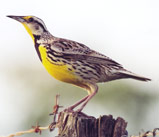Access to birdwatching site
This bog is encircled by an 8km loop of back road that includes
a piece of Chemin du Brûlé and all of Chemin
du Fer-à-cheval. There are many interesting places
for the motorist or the cyclist to stop on this circuit.
The area
The road is wide and infrequently used and so it is possible
to stop on the roadside without disrupting the local traffic.
From the road, you can see a number of different bird habitats
such as; the peat bog, a mixed forest, stands of conifers,
and open fields.
Birds to watch for
The following are suggested stops for birdwatching. Kilometers
are calculated starting at the crossroads of Chemin du Brûlé and
Chemin du Fer-à-cheval at the point where you arrive
from Compton and right on Chemin du Brûlé.
Stop no.1 (1.2 km to 1.7 km)
Facing the peat bog: Look for the American Woodcock and the
Willow Flycatcher. You might also spot the Palm Warbler
as bogs are one of this bird’s favourite habitats.
Stop no.2 (2.3 km)
At the junction of Chemin du Brûlé and Chemin
du Fer-à-cheval: Watch for meadow birds such as the
Eastern Meadowlark and the Barn Swallow.
Stop no.3 (3 km to 3.3 km)
Facing a fallow farm field: You will see an abundance of
Bobolink as well as the Cliff Swallow.
Stop no.4 (3.8 km to 4.3 km)
In the first curve of Chemin du Fer-à-cheval: Here
you will easily spot a large population of Lincoln Sparrow
and many species of warblers and sparrows.
Stop no.5 (5.7 km)
A large pine tree plantation plays host to the Field Sparrow.
On the other side of the road, Eastern Bluebirds nest and
Brown Thrashers can be easily seen.
Stop no.6 (6.5 km)
A lovely forest of conifers where the Cape May Warbler and
other species of this type of habitat can be observed.
Stop no.7 (6.8 km)
In the last curve of Chemin du Fer-à-cheval, before
you return to your departure point and the beginning of the
circuit: At this spot, you can often make an unusual sighting:
a colony of Tennessee Warblers —a species whose usual
range is much farther north— nests here.
|







